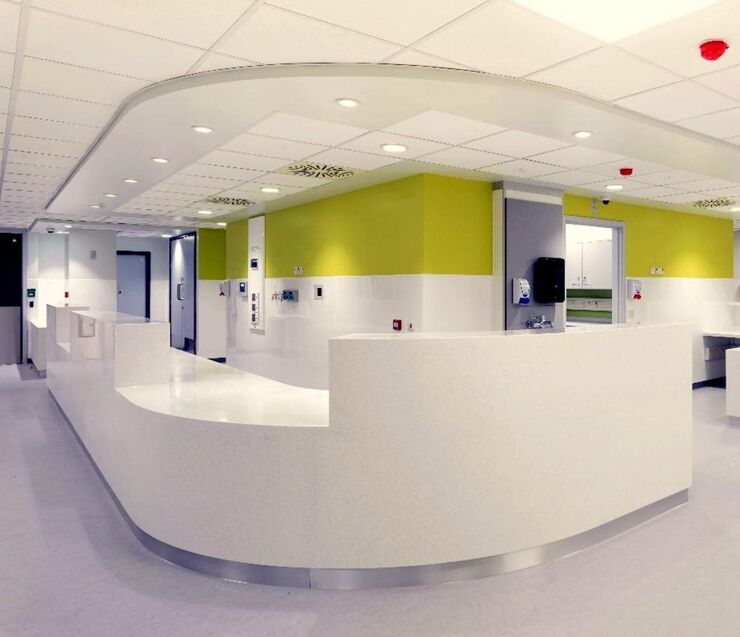
 |
NEC Project of the Year Highly Commended 2018 |
 |
NEC Contractor of the Year Highly Commended 2018 See the other Winners here |
A new NEC-procured accident and emergency department has been successfully delivered at St Thomas’ Hospital in central London, UK. The £19 million project and its contractor Logan Construction were both highly commended in the 2018 NEC Awards for using collaboration to overcome the challenges of working in a live hospital environment.
Client Guy’s and St Thomas’ NHS Foundation Trust and its estates arm Essentia engaged ADP Architecture and Logan to deliver a new 4,400m2 ground-level emergency floor within the existing Lambeth and East wings to improve services to the 140,000 patients who attend the hospital each year. Construction was procured under an NEC3 Engineering and Construction Contract Option A (priced contract with activity schedule).
The project included creating a new emergency department entrance and waiting area, a 62-bed admission ward with ensuite facilities, an urgent care centre, a dedicated children’s emergency department with a six-bed short-stay unit, and an improved resuscitation area with dedicated trauma and isolation rooms. Work started in March 2014 and was completed within budget and on programme in May 2018.
Uninterrupted Operation
On completion of the project, clinical lead Katherine Henderson said, ‘I am incredibly proud of the fact that such a huge redevelopment has been carried out while existing emergency services have remained open 24 hours a day. Our new department will improve the quality of care as well as the overall experience of patients requiring emergency treatment.’
The NEC Awards judges said, ‘Co-operation between many stakeholders was key to the successful delivery of this project. The challenge was to refurbish the emergency department of one of London’s major hospitals while keeping the facility running.
‘We were impressed by the level of flexibility, understanding and engagement shown by the contractor and designer throughout with the hospital team. The project is a very good example of collaborative relationships to manage a complex programme in the challenging environment of an emergency department.’
Flexible and Adaptable
According to Jennifer Shaw, director of asset management at the Trust, ‘The whole project team acted in accordance with NEC’s ‘spirit of mutual trust and co-operation’ throughout the contract. Maintaining uninterrupted operation of the emergency department throughout the duration of the works was critical, so the project team’s approach needed to be flexible and adaptable to meet the ongoing requirements of the department.
The contractor’s construction director Tony Kemp says, ‘The originally devised programme was, upon closer review, found not to be ideal when considering the department needed to operate as usual throughout the construction period. We took the main phases as previously identified and broke them down into many smaller sub-phases to fit the needs of the hospital and maintain patient safety. As is possible with NEC, the programme and phases continued to be adjusted throughout the project, as and when changes were required or additional scopes of work were included.
With the close proximity of the project to life-critical activities, Kemp says a continual collaborative approach was essential, with multiple channels of regular communication occurring between all project stakeholders. ‘Logan Construction and ADP collaborated very closely not only with the trust and estate teams but directly with the clinical team too, which was vital to the project’s ongoing success and the positive feedback received.’
Spirit of Collaboration
He says in the NEC spirit of collaboration, the architect and contractor were keen to get feedback from all the stakeholders on the way they were approaching and dealing with the scheme. ‘Weekly meetings were held with representatives of the surrounding live areas at which both the recently completed tasks were reviewed and the forthcoming operations explained. We thus had constant feedback from the ‘sharp end’ and this input was duly used to refine the strategy we would take going forward.’
The contractor encouraged the clinical teams and end users to visit site regularly and review the work being undertaken, giving feedback on the areas underway. From this, comments were received and required design changes were subsequently incorporated into the construction process. For example, writing desks for medical staff were initially specified to be at normal desk height. Following a visit, staff decided that the desks would be better at standing height, enabling them to write while walking past, and the design was changed accordingly.
Kemp concludes, ‘Team working as a collective is often mentioned in the construction industry, but seldom truly achieved. From the outset, the collaborative approach instilled by the NEC contract was adopted by all parties and was a major factor to the project success.’
Benefits of Using NEC
- NEC3 clause 10.1 requirement to work in a ‘spirit of mutual trust and co-operation’ helped to ensure the project team collaborated closely the client team to deliver this complex project in a live hospital environment.
- NEC flexibility allowed the programme and phases to be continually adjusted throughout the project to suit operational needs or when additional scopes of work were included.
- NEC early warning and risk management processes helped to ensure this challenging project was delivered on schedule and within budget.


